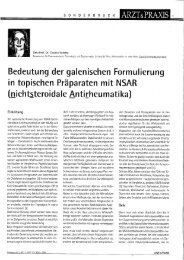Diclofenac Sodium 4% Spray Gel - cyathus.cz
Diclofenac Sodium 4% Spray Gel - cyathus.cz
Diclofenac Sodium 4% Spray Gel - cyathus.cz
Create successful ePaper yourself
Turn your PDF publications into a flip-book with our unique Google optimized e-Paper software.
PAR <strong>Diclofenac</strong> <strong>Sodium</strong> <strong>4%</strong> <strong>Spray</strong> <strong>Gel</strong><br />
UK/H/0562-3/001/E01<br />
The clinical expert supplies a bibliographic review of the clinical pharmacology and<br />
the clinical trials, and the applicant has also submitted three sets of clinical data of<br />
relevance: two pharmacokinetic studies and a placebo-controlled clinical trial<br />
involving 236 patients with accidental injuries of the ankle<br />
Tabulated summaries are provided for these studies.<br />
Sufficient validation has been presented to permit claims for this product to be used<br />
for the local and temporary treatment of acute trauma to the ankle shown in the<br />
clinical study described above.<br />
SUMMARY OF PRODUCT CHARACTERISTICS<br />
The Summary of Product Characteristics is satisfactory.<br />
POST-MARKETING EXPERIENCE<br />
Approximately 1.1 million patients have been treated with an identical topical<br />
formulation marketed since 1999 and 2001, respectively.<br />
From August 1999 until March 2004 three spontaneous reports of adverse events after<br />
topical administration are known. One of the cases was described as “tongue oedema<br />
and sense of respiratory obstruction”. The adverse event was considered as drug<br />
related, due to an individual hypersensitivity to the drug. The second event was a<br />
“cutaneous dyschromia with subcutaneous adipose necrosis preceded by a local<br />
erythema”. The event occurred after one week of treatment and cleared up with<br />
permanent after-effects. It was therefore considered serious. The third event was<br />
described as “pruritus and erythmatous exanthema on the site of application”. It<br />
occurred after 14 days topical treatment. The seriousness of the reaction was not<br />
defined in the report.<br />
There have been four periodic safety update reviews (PSURs) since the original<br />
national licence was granted, covering periods between 13 May 2002 to 13 November<br />
2002, 14 November 2002 to 13 May 2003, 14 May 2003 to 13 November 2003 and 14<br />
November 2003 to 13 May 2004.<br />
DISCUSSION AND RECOMMENDATIONS<br />
There are no medical reasons why these applications should not be granted.<br />
30



